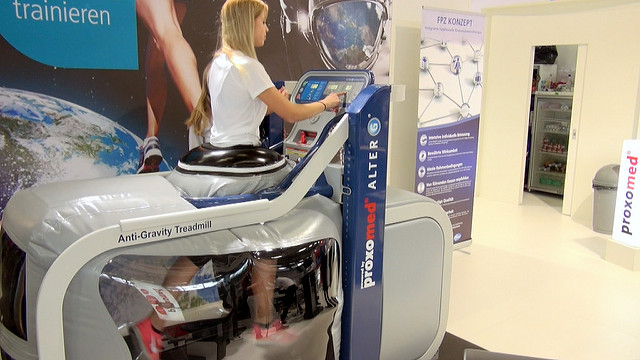Gravity is a constant. But the appearance of gravity can be manipulated through air pressure, to the benefit of both astronauts exercising in space and patients rehabilitating on the ground. When NASA researchers sought to replicate gravity in space, they developed a device that could alleviate gravity here on Earth. The AlterG, or anti-gravity treadmill, as it is somewhat dramatically known, is said to simulate walking on the moon. Although novel, why produce a machine that lessens gravity, when more space program resources have been directed toward generating gravity in space?
A decade ago, the first astronaut ran the Boston Marathon in space, giving a new meaning the phrase “space race.” Sunita Williams anchored herself to the International Space Station’s TVIS (Treadmill with Vibration Isolation System) treadmill, wearing a harness the entire time. In 2009, ISS was upgraded to a cheekily-named COLBERT (Combined Operational Load Bearing External Resistance Treadmill) treadmill.
It might be surprising to learn that ISS has a treadmill at all, as it is not necessarily the most popular piece of exercise equipment. The predecessor to the treadmill was the tread wheel, which was in fact used in 19th century Britain as a punishment for prisoners, and eventually outlawed in the early 1900s “after outcries of it being seen as cruel and unusual.”
But ISS is equipped with a treadmill because exercising in a weightless environment is important. Astronauts need to exercise all the more in microgravity to avoid bone loss and muscle atrophy. Since the International Space Station was launched in 1998 (and with its Skylab and Mir predecessors), space agencies have had to invent ways to keep astronauts healthy and ready for reentry after an extended stay in space.
During his work as an engineering graduate student at Stanford, and later as an employee of NASA, Robert Whalen studied the biomechanics of keeping humans healthy in space. He conceived the anti-gravity treadmill as a way for astronauts to maintain bone and muscle strength in zero-g. Although aerobic activity helped, astronauts still suffered bone and muscle loss, and even a loading harness didn’t quite do the trick. “Whalen then began to consider the use of air pressure as a way of applying a strong force—equal to body weight—to astronauts during treadmill exercise that would work better than the waist harness system.”
By 1992 Whalen had patented “gravity differential technology,” but the unloading treadmill never made it to space. Instead, Whalen’s son Sean stumbled across the prototype sci-fi device in his father’s garage. In 2005, Sean Whalen started a company with the use of his father’s patent, aiming to help rehabilitate people. Since then, the applications of the AlterG treadmill have only multiplied.
Runners – including many high-profile names – use the machine both to rehabilitate and train in a low-impact environment. Patients learning to walk and exercise again are relieved to encounter the supported environment of the AlterG treadmill. Seniors facing knee, hip, and ankle replacements can strengthen their joints and muscles without causing further damage. People suffering obesity can exercise without the usual strain and make meaningful progress towards weight loss. The AlterG can even be used to test cardiovascular health. And patients with neurological conditions like multiple sclerosis, cerebral palsy, and Parkinson’s can use the AlterG to improve coordination and balance. As Barry Heyden, a former New York Mets coach, put it: “‘Once you’re in there, you can’t fall.’”
But the AlterG is bulkier than a regular treadmill, owing to the airtight chamber encasing the lower half of the runner’s body. Runners wear a special pair of neoprene shorts with an attachment that zips them into the chamber, enclosing the treadmill and their legs. Adjusting the air pressure within this chamber lets users experience a downward pressure akin to body weight, which would help astronauts exercise in space. Increasing the air pressure here on earth provides a kind of buoyancy for users, softening the impact on their joints. The machine is carefully calibrated as well, so that you can apply from 20% to the normal 100% percent of the user’s body weight, in one percent increments. But users are essentially zipped into half a bouncing castle. As Bloomberg’s test subject put it, “‘I look like I’m auditioning to be a centaur in Clash of the Titans.’”
Improvements to the AlterG are underway, including an easier way in and out of the machine, as well as giving doctors the ability to adjust patients’ limbs while they are in the chamber. As studies are conducted to show the benefits of this relatively new tool for rehabilitation, the anti-gravity treadmill will surely acquire additional use cases and become an integral part of many more success stories.

